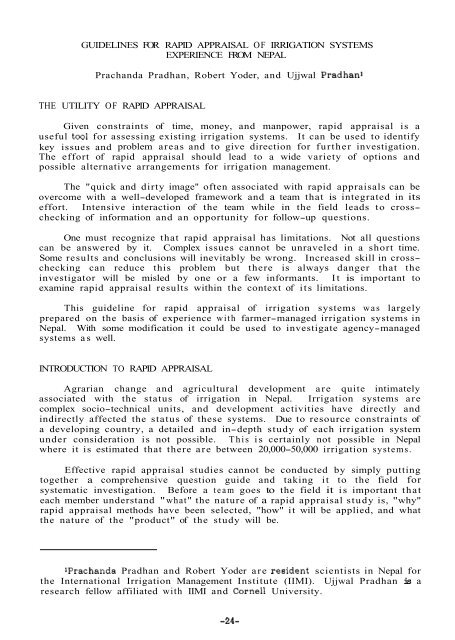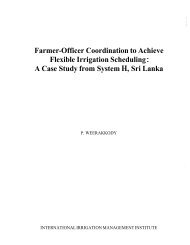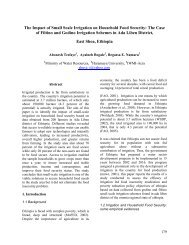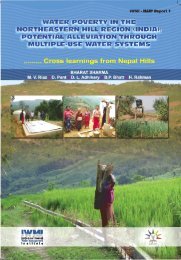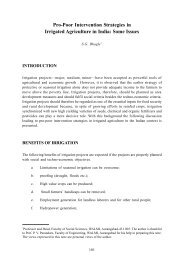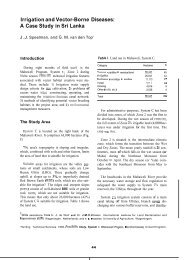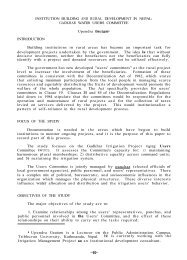GUIDELINES FOR RAPID APPRAISAL OF IRRIGATION SYSTEMS ...
GUIDELINES FOR RAPID APPRAISAL OF IRRIGATION SYSTEMS ...
GUIDELINES FOR RAPID APPRAISAL OF IRRIGATION SYSTEMS ...
You also want an ePaper? Increase the reach of your titles
YUMPU automatically turns print PDFs into web optimized ePapers that Google loves.
-Have new settlers (authorized or unauthorized) been allowed to join?-Have segments of the system left?-Has there been amalgamation, incorporation of systems?111. DESCRIPTION <strong>OF</strong> THE SYSTEMA.1.The physical systemHydrology-Source(s) of water.-Catchment area.-Rights to water in source: upstream and downstream systems.-Seasonal variation of water supply at extraction point.-Discharge in canal at extraction: maximum and minimum for each crop.-Flood frequency.-Drought frequency.-Water quality: salt, lime, etc.-Other uses of water: power, fire protection, animals, etc.-Water constraints to expansion/intensification of irrigation.2.Canals: main and branch-Type of construction, materials, quality, and condition.-Seasonal and long-term changes.-Sketch or map of layout.-Distance from source to first fields.-Length of main canal in command area.-Design capacity of main and branch canals.-Density: including field canals (m/ha).-Condition of rock and soil along alignment.-Condition (specify in which season).3.Structures-Type of construction, materials, quality, and condition.-Seasonal and long-term changes.-Intake/diversion.-Regulators: gates, fixed.-Cross drains.-Aqueducts, siphons, drop structures.-Measuring devices.-Main turnouts: type, number.4.Boundaries of the irrigated area-Irrigated area for each crop.-Changes in system over time: amalgamation, expansion, or loss.-Limitation of expansion for each crop: physical, water rights.5.Drainage-In command area.-Escapes from canals.-31-
6. Soils.-Type: head, middle, tail.-Fertility and suitability for irrigated agriculture.IV.A.OPERATION AND MAINTENANCEActivity/problems-Related to water acquisition: water rights, paucity of supply, damagefrom floods, etc.-Related to water delivery: canal cleaning, landslide repair, flood damage,crabs, animals, seepage.-Related to water distribution and drainage.-Priority tasks in O&M: maintenance of diversion and canal or waterdistribution.B.Water distribution tasks (Frequency and magnitude of effort)-Method of water distribution for each crop and variation during eachcrop: rotation (who and how initiated, frequency of turn); continuousflow; contract; turns (head to tail).-Distribution during water-short period: rotation among outlets, amongfield neighbors within outlet.-Match between water distribution and allocation: method of matching,proportioning weir, timed rotation.-Relationship of water distribution to physical infrastructure.-Who is responsible for water distribution activities?C.Routine maintenance-What work is done.-Frequency.-Purpose: improve performance, preventive.-How long does it take?-Who initiates and directs work?D.Emergency maintenance-Reasons.-Frequency.-How long does it take?-Who determines it is an emergency?-Who organizes and leads the work?E.Extent of agency involvement in system-What agency is involved?-Management input of agency.-Agency organization for water delivery and O&M.V.A.INSTITUTIONS AND SOCIAL ENVIRONMENTSocial structure-32-
-Landholding pattern.-Nature of tenancy (criteria: owner, tenant, sharecropper).-Ethnic composition in the command.-Villages.-Settlement pattern and irrigation labor availability.-Power structure (related to 1qnd and panchayat affiliations).-Religion.-Kinship pattern.-Leadership: formal, informal,-Migrants: where from, previous irrigation experience.-Non-agriculture employment.-Seasonal migration for employment.B.Organization for irrigation operation and maintenance1. Membership-Criteria: land, water share, crop, tenancy, official panchayat position,contractual, ethnic (exclusions), gender, age, labor, investment input.-Membership in other systems.-Absentee members.2. Roles and positions-For each position include: method of nomination, appointment, tenure,remuneration (cash, in kind, labor exemption).-Appointed functionaries.Chairman.Vice-chairman.Secretary.Treasurer, etc.Water supply and/or system damage monitor.Crier.External communications.Moderator of meetings.Tool keeper,-Committees: regular and ex officio.-Informal leaders.-Relationship of panchayat and political leadership to system.3. Tiers of organization-Federation/unitary.-Central.-Regional/dis tributor y.-Village/ferm channel (mauja).4. Meetings-Regular: time, place, who calls.-Extra.-purpose: resource mobilization, accounts, maintenance, conflict.-Attendance: landlords, tenants, women.-Penalty for not attending.-Leadership: moderator, minute keeper, how selected.-33-
-How are resolutions passed'?-Records of meeting.vote, consensus.5.Conflict and conflict management-Cause, nature, frequency of conflict.-Speci'ic to cropping season?-Internal or external to the system.-Among systems.-Non-water issues.-To whom is first appeal for conflict resolution and what is the step-bystepprocedure for difficult cases?-What is handled within the organization and what is taken outside?-Police cases.-Court cases,-Panchayat involvement.-Rules and sanctions.-Records of conflict resolution.6.Water rights at system level-Sharing with other system.-Permit, rent, prior appropriation, riparian.-Customary rights.-Evidence of conflict among systems.I.Water allocation (water righta of members within system)-Rases for allocation principle: land area, soil, investment, purchased,traded.-How does water allocation change with crop, level of water supply.-Outside influence due to assistance.-Dominance of one social group.8.Internal resource mobilization-Purposes for resource mobilization.-Basis: same as water allocation, household.-Type of resource: cash, labor, in kind (remuneration, etc.), animal,bullock cart, local knowledge.-Organization to manage.-Accounts of resources due and contributed.-Annual quantity of each type of resource.-Sanctions for not contributing.-Annual amount realized from fines, how collected and used?-What is consequence of not paying fine?-Where are funds and in-kind resources held? Is there intermediate(short-term loans) use?-Discrimination against contribution: caste, sex, age.-What if family does not have male member?-Contractual arrangements for maintenance: method, reason.-Resource generating activity: mill.9.External resources-Purpose.-Source: connections, contacta.-34-
-Who (person) initiated contact with outside agency, incumbent or previousexperience in government position.-Frequency.-Type: cash, food-for-work, cement, gabion wire, technical advice.-Equipment: bulldozer, jackhammer.C.Organizational development.-Changes over time in: rides, roles, resource mobilization, processes forelecting functionaries, etc.-Changes in decision-making process.-Process of allowing new outlet from main canal.-Terms and conditions of external agency for providing aid and resolvingconflict.-Change in involvement of panchayat or district offices.-Changes in relationships with other systems: water sharing whentemporary damage in canal, sharing resources for maintenance.VI.A.1.DESCRIPTION <strong>OF</strong> THE AGRICULTURAL SYSTEM AND SERVICESAgricultural systemGeneral-Main crops.-General condition of crops.-Cropping pattern (provide a rough sketch map indicating the cropsgrowN in different locations).-Crop calendar.-Cropping intensity.-Estimated yield.-Change in agricultural practices in past 25 years: new crops, varieties,technology.-Mechanization vs. labor-intensive system.2.Production inputs-Use of improved of seed.-Use of fertilizer.-Extension services (types, training, production campaign).-Price of inputs.3.Agricultural practices-Land preparation methods.-Use of manure, fertilizer.-Broadcasting or transplantation.-Yield per crop.-Tots1 yield per year.-Prices and marketing.VII. SYSTEM STRENGTH AND WEAKNESSA. Strengths.B. Weaknesses.-35-
APPENDIX 2<strong>IRRIGATION</strong> SYSTEM ACTIVITIES MATRIXAll irrigation systems require that certain essential tasks be accomplishedif the system is to function productively. One set of management activitiesfocuses directly on the water. Water must be acquired, allocated, distributed,and, if there is excess, drained. A second set of management activities dealswith the physical structures for controlling the water. A final set of activitiesfocusses on organization which manages the water and structures and includesdecision making, resource mobilization, communication, and conflict management.There is interaction among the activities of the three sets; for example,the organization must decide how to operate the structures to distribute thewater. The matrix shown in the figure illustrates these interactions. Not allactivities are equally important in each environment, and the farmers' irrigationmanagement institutions will reflect the relative importance of activities in aparticular location.For a rapid appraisal study it is instructive to use the matrix to formulatequestions about the management of the system. Each of the 64 boxes is apotentially important interaction. For example, one might ask what decisionsneed to be made about the operation of the system as it relates to waterallocation. Often whole blocks of interactions "boxes" are not relevant for aparticular system. This matrix is useful for examining the activities internal tothe irrigation system.-36-
<strong>IRRIGATION</strong> SYSTEM ACTIVITIES MATRIXAdapted from:Uphoff, Norman, Ruth Meinzen-Dick, and Nancy St. Julien. 1985.Getting the process right: farmer organization and participation in irrigationwater management. A State-of-the-Art Paper prepared at Cornell University forthe Water Management Synthesis I1 Project, Consortium for InternationalDevelopment, Cornell University, Ithaca, NY.-37-


